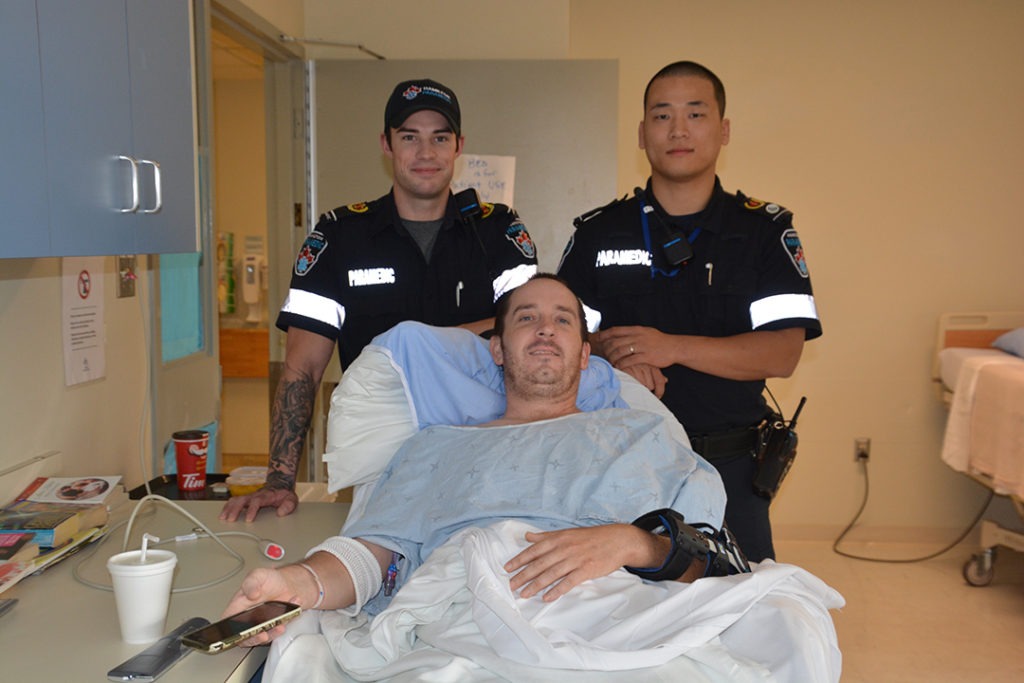
Trauma team saves man crushed at construction site
The day that changed his life
It’s 9:37 AM on October 5th.
Dr. Edward Passos, trauma team leader at Hamilton General Hospital (HGH) is sitting in his office. His pager sounds. A patient is on his way to the regional trauma centre from a construction site on the Hamilton Mountain.
“When we get pages like this, we know it’s very serious,” says Dr. Passos. “It’s our cue to gather everyone on the team and plan how we’re going to make sure this patient survives.”
“All of a sudden, I got hit from behind and fell. I felt my left arm go limp.”
Joey Hackett, a construction worker, was working at a large site when he noticed a co-worker trying to get his attention.
“We were grading a road. I saw a guy waving me down,” Hackett says. “All of a sudden, I got hit from behind and fell. I felt my left arm go limp. I could hear my pelvic bone cracking. It was terrifying.”
“I honestly didn’t know if he was going to make it,” says Sean Kim, one of the paramedics who rescued Hackett from the scene. “He was in really rough shape. His foot was like a bag of bones.”
“I remember two dark screens closing in fast, like something on a computer,” Hackett recalls. “Then it got cold really fast. I remember the paramedics talking about getting me on the spinal board and deciding what they were going to do with my arm.”
Flash forward fifteen minutes. Joey is arriving at HGH, where the trauma team is waiting for him. At the head of the bed, the anesthesiologist and respiratory therapist prepare to put a breathing tube into his lungs. Joey’s blood pressure drops. He is bleeding internally from his severely fractured pelvis and other internal injuries. Dr. Passos calls for an immediate massive blood transfusion. A team of General and Orthopedic surgeons assess his abdomen and pelvis. Once Hackett is stable he’s sent to interventional radiology to help control the bleeding. By this point, nearly a dozen expertly trained clinicians have contributed to the case.
 Joey getting a final goodbye from his trauma care team.
Joey getting a final goodbye from his trauma care team.
“Joey is a prime example of how several teams – from our paramedic partners to our emergency and trauma team to our colleagues in critical care, anesthesia, surgery, radiology, neurology and rehabilitation and so many others –work together to save lives,” says Dr. Jamal Al-Asiri, an orthopedic surgeon who cared for Hackett. “I knew this was going to be a high stakes case but once we gathered together and set a plan, we were confident we could take care of him.”
This interdisciplinary and highly specialized approach to trauma care is essential to saving and improving lives at HGH, which receives referrals from more than 22 regional hospitals and serves a catchment area of more than 2.5 million people.
“You can’t understand how beyond amazing they are until you experience something like this.”
“There are no words to describe how much love is put into you by the trauma team,” says Hackett. “You can’t understand how beyond amazing they are until you experience something like this. Every nurse, every environmental aide, every porter, every surgeon, every visitor that held the elevator door, the ladies that sing in the cafeteria. They all made my recovery possible.”
Joey spent time in the OR, ICU and trauma unit on 6 South. He persevered with his physiotherapy and occupational therapy, eventually gaining the ability to sit at 60 degrees in a stretcher chair where he could finally leave his hospital room. His shattered ankle and damaged elbow would demand a longer recovery before he can bare weight. After spending almost two months in the hospital, Hackett finally got the all-clear to return home to his family. He will still require special equipment and supports at home.
A final goodbye
Before he left the hospital, he received a surprise visit from the paramedics who rescued him from the construction site.
“I just can’t believe they came,” he says“ I just wanted to shake their hands and thank them for everything. It was amazing to have the chance to do that.” On his last day at HGH, he got a final goodbye from his entire care team. Surrounded by more than a dozen health care providers who, together, gave him a second chance at life, Hackett felt ready to go home.
Life back at home
“Life at home has been challenging,” says Hackett’s wife, Tara. “He has been rolling with the punches and making it work. I don’t think we would be doing this well if it weren’t for the care he received.”
“Patients like Joey, who receive care from a multidisciplinary trauma team have a significantly higher rate of survival,” says Dr. Samir Faidi, medical director for the trauma program at Hamilton Health Sciences. “We’re able to integrate all different elements of care, and that greatly improves outcomes”.
Since the accident, Hackett has regained mobility in his fingers and elbow and is optimistic about the future. He will be back at HGH soon for intensive rehab. He has a long road ahead of him but his wife, son, family and —along with his team at HGH—are all by his side.
